Adelie Penguins
This post was in progress when we lost our internet connection two weeks ago... Carrying a rock back to the nest
Carrying a rock back to the nest.
Adelie penguins nest along the Antarctic coastline in areas where persistent winds keep the rocks free of ice and snow. During the winter they migrate north to the edge of the winter ice, where they can still find some open water and a few hours of daylight. In spring they return to their breeding areas. The males are the first to arrive, establish territories, and build nests out of small pebbles.
 Male proclaiming his territory
Male proclaiming his territory.

Neighbors settling their territorial boundaries (bill-gaping). Stealing a rock from the absent neighbor's nest.The pebbles help to keep the eggs and chicks dry and warm, away from the spring thaw. They are thus considered of utmost importance, and Adelies will go to any length to collect as many pebbles as they can in as short a distance as possible. Sometimes this means stealing them directly from an unsuspecting or absent neighbor.
Stealing a rock from the absent neighbor's nest.The pebbles help to keep the eggs and chicks dry and warm, away from the spring thaw. They are thus considered of utmost importance, and Adelies will go to any length to collect as many pebbles as they can in as short a distance as possible. Sometimes this means stealing them directly from an unsuspecting or absent neighbor. Adelie pair flirting.The females arrive shortly after the males, seek out their mate from the previous year (or find a new one if the previous mate is absent), and establish a pair bond. Once paired the two are able to recognize each other by voice. Within a few days they copulate, lay 1-2 eggs, and thus begin their annual nesting cycle. The males take the first incubation shift while the females go to sea to recuperate some of the energy lost in producing the eggs. The eggs hatch within about 30 days.A great deal of energy is spent in defending the nest from pesky intruders: neighbors who walk too close to the nest, previous occupants who try to reclaim their lost territories, skuas out looking for a meal (some skuas specialize in eating penguin eggs and chicks), and penguin biologists such as ourselves.
Adelie pair flirting.The females arrive shortly after the males, seek out their mate from the previous year (or find a new one if the previous mate is absent), and establish a pair bond. Once paired the two are able to recognize each other by voice. Within a few days they copulate, lay 1-2 eggs, and thus begin their annual nesting cycle. The males take the first incubation shift while the females go to sea to recuperate some of the energy lost in producing the eggs. The eggs hatch within about 30 days.A great deal of energy is spent in defending the nest from pesky intruders: neighbors who walk too close to the nest, previous occupants who try to reclaim their lost territories, skuas out looking for a meal (some skuas specialize in eating penguin eggs and chicks), and penguin biologists such as ourselves. Adelie dispaying from its nest, "daring" me to come closer.
Adelie dispaying from its nest, "daring" me to come closer. The sideways stare, usually followed by multiple growls. Not a good sign.Adelies also spend a considerable amout of time preening. Healthy, well-oiled feathers help to insulate them from the cold and maintain a hydrodynamic exterior.
The sideways stare, usually followed by multiple growls. Not a good sign.Adelies also spend a considerable amout of time preening. Healthy, well-oiled feathers help to insulate them from the cold and maintain a hydrodynamic exterior. Adelie reaching for its preen gland.
Adelie reaching for its preen gland.
More lichens and other things...
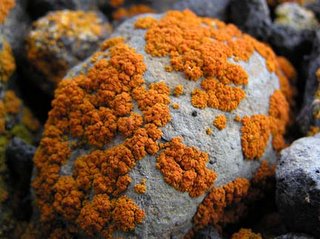
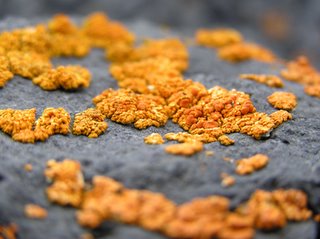 More orange lichens...
More orange lichens...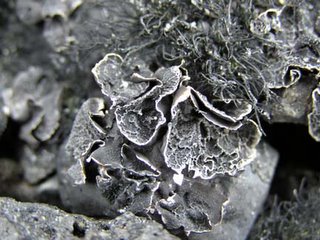 Usnea and Umbilicaria (two lichens).
Usnea and Umbilicaria (two lichens). Orange lichen, and algae-covered bird vertebra.Terrestrial life in Antarctica is limited to a few species of mosses, lichens, snow algae, mites and springtails. The lichens grow along crevices and between rocks. Some thrive where the snow melts and mixes with bird guano. Most life is in the sea or along the shore - seabirds, whales, seals, and marine invertebrates all make their living in the ocean. Some seabirds, like Adelie penguins, south polar skuas, and snow petrels, use land for nesting but are otherwise sea-bound most of the year. Emperor penguins hardly ever walk on solid ground. They nest on the sea ice and therefore spend nearly 100% of their time in or on the ocean. Weddell seals occasionally haul out on the beaches (and rarely wander further inland), though they are usually found sleeping on the sea ice or on wayward floes - dark blobs in an otherwise flat expanse of ice and shiny sea. Their torpor is almost contagious. Leopard seals breed and sleep on ice floes and sometimes work the tide cracks and ice edges in search of a penguin meal, catching unsuspectig penguins as they jump in and out of the water.
Orange lichen, and algae-covered bird vertebra.Terrestrial life in Antarctica is limited to a few species of mosses, lichens, snow algae, mites and springtails. The lichens grow along crevices and between rocks. Some thrive where the snow melts and mixes with bird guano. Most life is in the sea or along the shore - seabirds, whales, seals, and marine invertebrates all make their living in the ocean. Some seabirds, like Adelie penguins, south polar skuas, and snow petrels, use land for nesting but are otherwise sea-bound most of the year. Emperor penguins hardly ever walk on solid ground. They nest on the sea ice and therefore spend nearly 100% of their time in or on the ocean. Weddell seals occasionally haul out on the beaches (and rarely wander further inland), though they are usually found sleeping on the sea ice or on wayward floes - dark blobs in an otherwise flat expanse of ice and shiny sea. Their torpor is almost contagious. Leopard seals breed and sleep on ice floes and sometimes work the tide cracks and ice edges in search of a penguin meal, catching unsuspectig penguins as they jump in and out of the water.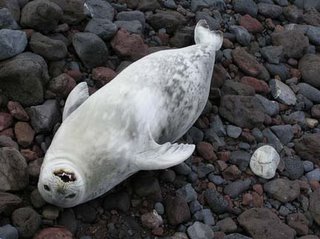
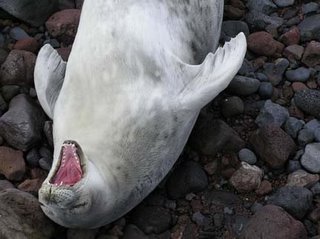 Weddell seal yearling dozing and yawning on the beach.
Weddell seal yearling dozing and yawning on the beach.
Colors
 Tonight's dinnerA few days ago a helicopter brought us a food resupply, which included one amazing, colorful box of fresh fruits and vegetables. This is one of the most unlikely sights in Antarctica, and a very welcome change from the dull, mushy, and bland world of canned and frozen goods. It's also the most colorful thing I have seen since we arrived in mid-November aside from the bright orange lichens that grow in the swales along the rocky slopes of Cape Crozier.
Tonight's dinnerA few days ago a helicopter brought us a food resupply, which included one amazing, colorful box of fresh fruits and vegetables. This is one of the most unlikely sights in Antarctica, and a very welcome change from the dull, mushy, and bland world of canned and frozen goods. It's also the most colorful thing I have seen since we arrived in mid-November aside from the bright orange lichens that grow in the swales along the rocky slopes of Cape Crozier.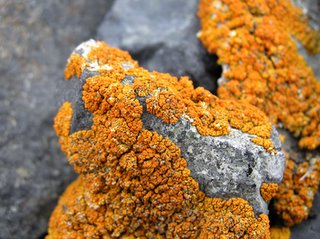 A lichen-encrusted rockTonight Grant made a delicious dinner of (frozen) halibut with fresh eggplant, peppers, and dried shiitake mushrooms, which were a gift from our friend Ben who arrived at McMurdo a few days ago and sent us some goodies on the same helicopter that brought the vegetables.
A lichen-encrusted rockTonight Grant made a delicious dinner of (frozen) halibut with fresh eggplant, peppers, and dried shiitake mushrooms, which were a gift from our friend Ben who arrived at McMurdo a few days ago and sent us some goodies on the same helicopter that brought the vegetables.
Antarctic Fog
I'm back after a month of too much work, sporadic Internet (bad weather in December, which caused our solar panels to take in too little power), and a constant desire to be outside... Grant walking in the fogIn early December we had a small storm - small by Crozier standards, with winds to 80mph - that blew away the apparently essential white plastic tube that covered our wireless antenna. A few days later Grant and I decided to go look for it out on the ice. We figured that, given the predominantly southerly winds, the tube must have blown along the kilometer-long snow field downhill and downwind of the hut and that it was either resting in the folds of some sastrugi (wind-carved snow) or lying on the fast ice (sea ice attached to the shoreline) at the bottom of the snow slope. The sky was clear and the hut was in full sun, but as we descended the slope we entered into a thick blanket of fog that lay low over the cold ocean. Our search suddenly turned from hopeful to mostly meditative, since the prospects of finding a white object on a white surface in the flat light of a dense fog bank are rather minimal. But I trudged on, marveling at the fact that Grant had totally vanished from my sight despite the fact that he was but 100m from me. He blurred in and out of view as he wove his way down the slope on this unlikely search. When we reached the bottom we stepped onto the frozen ocean with it hard, jagged, snow-covered surface keeping us from slipping on the blue ice beneath. A few hundred meters ahead lay several grounded tabular (flat-topped) icebergs. They formed a citadel in various stages of decay - ice deconstructed by wind and rearranged by the movements of larger bergs that occasionally collide with the coast, with deep gashes revealing ice's inner blue secrets. Here the fog was denser but lay in patches from which the citadel emerged. The light and the iceberg backdrop made it look like a stage in some kind of celestial theater. Then I noticed the penguins. There were hundreds of them on the fast ice heading back to the colony. They were arranged in a jagged single file and they called and grunted as they went along, some walking and some tobogganing on their bellies, using their feet to push themselves along and their flippers to steer and maintain balance. They were mostly males who had taken the first incubation shift after egg-laying, had gone out to sea on their first foraging trip, and were returning to their nests to relieve their mates once again. I sat down and watched them file by, not daring to cross their line to keep following the plastic tube's imaginary, wind-borne path, which at this point had taken on a secondary importance. Grant walked through a gap in the penguin line and continued looking for the tube in the ice folds at the foot of the citadel. I waited for another gap, crossed, and then followed the birds to the western end of the colony, where they finally fanned out as they headed for their respective nests.
Grant walking in the fogIn early December we had a small storm - small by Crozier standards, with winds to 80mph - that blew away the apparently essential white plastic tube that covered our wireless antenna. A few days later Grant and I decided to go look for it out on the ice. We figured that, given the predominantly southerly winds, the tube must have blown along the kilometer-long snow field downhill and downwind of the hut and that it was either resting in the folds of some sastrugi (wind-carved snow) or lying on the fast ice (sea ice attached to the shoreline) at the bottom of the snow slope. The sky was clear and the hut was in full sun, but as we descended the slope we entered into a thick blanket of fog that lay low over the cold ocean. Our search suddenly turned from hopeful to mostly meditative, since the prospects of finding a white object on a white surface in the flat light of a dense fog bank are rather minimal. But I trudged on, marveling at the fact that Grant had totally vanished from my sight despite the fact that he was but 100m from me. He blurred in and out of view as he wove his way down the slope on this unlikely search. When we reached the bottom we stepped onto the frozen ocean with it hard, jagged, snow-covered surface keeping us from slipping on the blue ice beneath. A few hundred meters ahead lay several grounded tabular (flat-topped) icebergs. They formed a citadel in various stages of decay - ice deconstructed by wind and rearranged by the movements of larger bergs that occasionally collide with the coast, with deep gashes revealing ice's inner blue secrets. Here the fog was denser but lay in patches from which the citadel emerged. The light and the iceberg backdrop made it look like a stage in some kind of celestial theater. Then I noticed the penguins. There were hundreds of them on the fast ice heading back to the colony. They were arranged in a jagged single file and they called and grunted as they went along, some walking and some tobogganing on their bellies, using their feet to push themselves along and their flippers to steer and maintain balance. They were mostly males who had taken the first incubation shift after egg-laying, had gone out to sea on their first foraging trip, and were returning to their nests to relieve their mates once again. I sat down and watched them file by, not daring to cross their line to keep following the plastic tube's imaginary, wind-borne path, which at this point had taken on a secondary importance. Grant walked through a gap in the penguin line and continued looking for the tube in the ice folds at the foot of the citadel. I waited for another gap, crossed, and then followed the birds to the western end of the colony, where they finally fanned out as they headed for their respective nests. Ice and penguins emerging from the fog
Ice and penguins emerging from the fog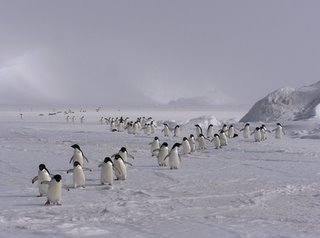 Adelies walking along the fast ice...
Adelies walking along the fast ice... ...and walking along the citadel towards the colony.
...and walking along the citadel towards the colony.




















